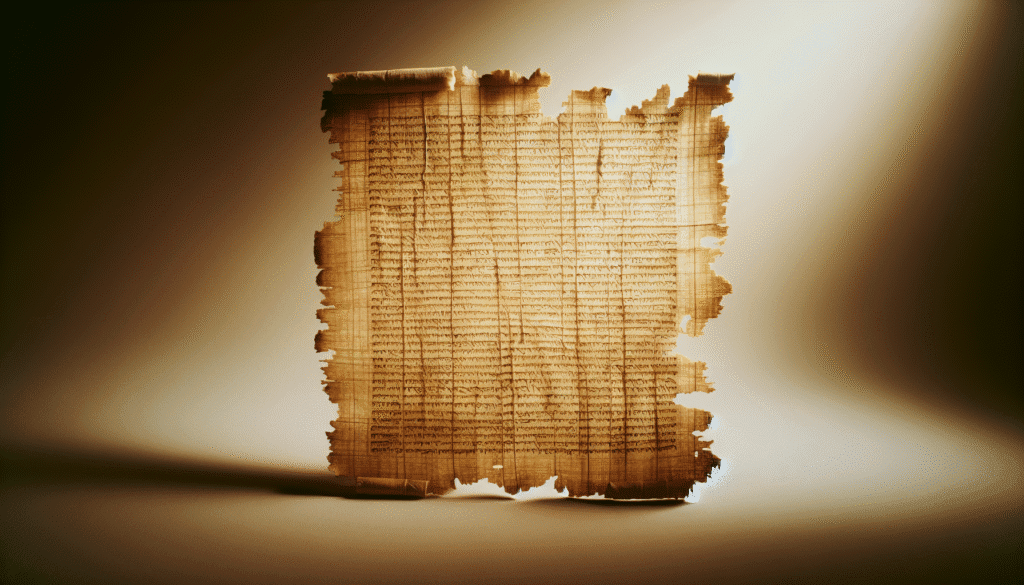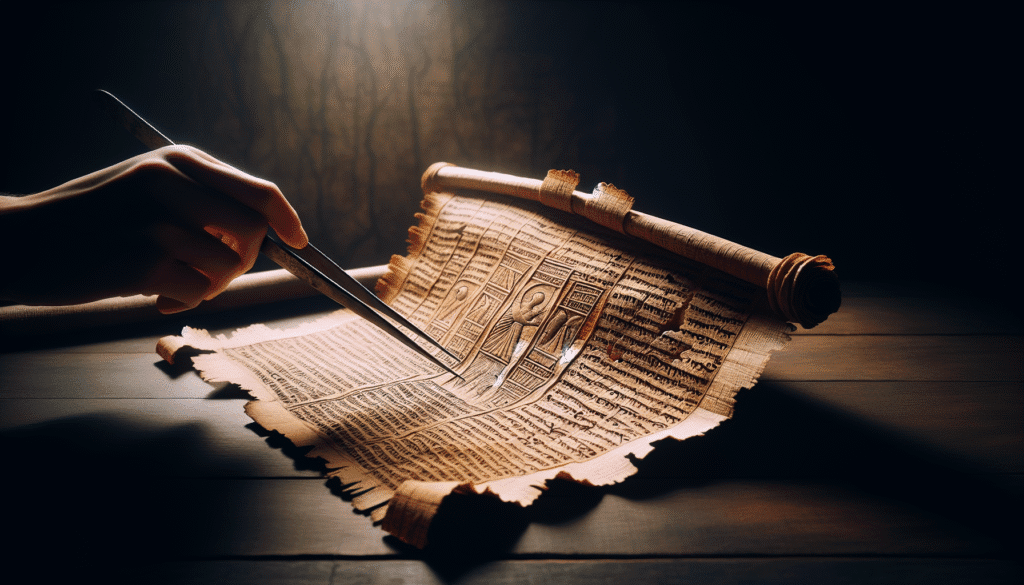Have you ever wondered what the oldest known fragment of the New Testament looks like, or what its existence means for history and religion today? If so, you’re in the right place. As someone with a PhD in Theology, I’ve spent considerable time studying ancient manuscripts, including an enlightening visit to the manuscript vaults where these historical treasures are preserved. What you’ll discover today is how a small piece of papyrus, known as the John Rylands Papyrus, has sparked fascinating debates about the early spread of Christianity and its texts. In 2025, the significance of this fragment may be greater than ever, especially as technology advances our capabilities to study ancient texts in innovative ways.
TL;DR Box
- The John Rylands Papyrus, also known as P52, is the oldest known fragment of the New Testament.
- Dated to the first half of the 2nd century, it contains a portion of the Gospel of John.
- It provides crucial insights into the early dissemination and textual consistency of the New Testament.
- Enhanced by modern technology, its ongoing study continues to influence both religious scholarship and textual criticism.
- This article addresses its history, significance, and the ongoing debates surrounding its interpretations.

History and Discovery of the John Rylands Papyrus
Unearthing an Ancient Treasure
The story of the John Rylands Papyrus begins in the early 20th century in Egypt, a hotbed for archaeological discoveries at the time. In 1920, a team of excavators working at Oxyrhynchus, a city renowned for its rich findings of papyri, unearthed what would later become known as the oldest fragment of the New Testament. This tiny piece of papyrus, officially labeled Papyrus Rylands Greek 457 (P52), might look unassuming at first glance, but its implications are enormous.
Arrival at the John Rylands Library
The fragment found its way to the John Rylands Library in Manchester, where it was catalogued and somewhat forgotten until 1934. It was then that C.H. Roberts, a scholar from Oxford, identified the text as a part of the Gospel of John, specifically the dialogue between Jesus and Pontius Pilate. This discovery would transform the papyrus into a cornerstone for New Testament studies and textual criticism.
Dating the Manuscript
Dating ancient manuscripts is a meticulous process. P52 was dated to the early-to-mid 2nd century by analyzing its script style, known as paleography. Although some debate continues about its precise date, the consensus places it between 125–175 AD, making it a crucial piece of evidence for biblical scholars studying the authenticity and age of New Testament writings.
Why Its Discovery is Groundbreaking
In 2025, the impact of the John Rylands Papyrus remains as significant as ever. With technology, new analytical methods have emerged that allow for even more accurate readings and interpretations. The fragment’s age and location suggest that the Gospel of John was in circulation much earlier than previously thought. As someone deeply involved in theological studies, I can attest to the way this fragment challenges previous notions and opens up new conversations about early Christianity.
The Textual Content of the Papyrus
What Does the Fragment Say?
The text on the John Rylands Papyrus contains portions of John 18:31-33 on one side and John 18:37-38 on the other. It’s a critical segment where Jesus converses with Pilate, discussing concepts of truth and kingship. Although it’s only a small part of the entire Gospel, each word has been meticulously analyzed and compared with later Gospel manuscripts.
Stylistic Features and Script
The papyrus is an excellent example of the Romano-Egyptian script type known as the ‘Bookhand’. This style, characterized by well-formed, rounded letters, was commonly used in the 2nd and 3rd centuries. For scholars, understanding the script offers clues not only to its dating but also to the cultural and geographical context of the text’s production.
Comparing Text Variants
Comparing the text from P52 with other Gospel manuscripts, such as the Codex Sinaiticus and Codex Vaticanus, offers insight into how the text may have evolved over time. In teaching classes on early Christian texts, I often use P52 to highlight both the consistency of the Gospel message over time and the small variants that did occur. Understanding these differences is crucial for students and scholars studying the transmission of biblical texts.

Impact on Textual Criticism and Theology
Shaping Our Understanding of the New Testament
The John Rylands Papyrus provides a critical benchmark for evaluating the textual accuracy of the New Testament. Prior to its discovery, the earliest manuscripts of the Gospel of John were believed to date from centuries later. P52, by its very existence, suggests a much earlier composition and transmission, forcing a reevaluation of timelines in early Christian history.
Theological Implications
For theologians, the implications are profound. By pushing the possible date of the Gospel of John closer to the lifetime of the eyewitnesses, the fragment potentially adds weight to arguments for the historical reliability of its accounts. As someone deeply engaged with theological debates, I find that such discoveries fuel a richer understanding of how early Christians documented their beliefs and experiences.
The Role in Modern Biblical Scholarship
In modern times, biblical scholarship remains informed by discoveries like this. Today’s scholars frequently revisit P52, utilizing technology such as spectral imaging to uncover previously unseen text details. The knowledge gleaned from this enhances our understanding of how early Christians shared and preserved their sacred texts.
Advances in Technology and the Study of Ancient Manuscripts
Innovations in Manuscript Analysis
In recent years, technological advances have revolutionized the study of ancient documents. Techniques like multispectral imaging allow researchers to read texts that are otherwise invisible to the naked eye. This was evident when I had the opportunity to observe such technology in action during a visit to a university’s manuscript lab. The precision and detail offered by these tools can reveal subtleties in P52 that further illuminate its history and significance.
Digital Access and Global Scholarship
The digitization of manuscripts, including the John Rylands Papyrus, has also democratized access, allowing scholars around the world to collaborate and share insights. The John Rylands Library has invested heavily in this area, promoting wider access and enabling ongoing global scholarship.
Future Directions
Looking ahead, artificial intelligence and machine learning present new frontiers for analyzing patterns and anomalies in ancient texts. These technologies could offer even deeper insights into textual lineage and authenticity, further refining our understanding of texts like P52.

Debates and Controversies
The Dating Debate
One of the most enduring controversies surrounds the exact dating of P52. While the majority consensus supports an early-to-mid 2nd-century date, some scholars argue for a slightly later composition. These debates often hinge on the interpretation of paleographic details, highlighting the continually evolving nature of this research field.
Questions of Authenticity
Discussions around authenticity also persist. Despite general agreement among experts regarding its genuineness, some skeptical voices question whether it truly represents the oldest New Testament fragment. However, repeated studies affirm its status, underscoring its significant role in biblical texts’ historical context.
Its Place in Christian Origins
The fragment’s implications for understanding early Christianity cannot be overstated. For some, it is a symbol of the religion’s rapid spread and the early church’s efforts to document its teachings faithfully. Whether you view it from a religious or historical perspective, P52 remains a focal point for understanding Christianity’s origins.
FAQs About the John Rylands Papyrus
What is the John Rylands Papyrus?
The John Rylands Papyrus, or P52, is the oldest known fragment of the New Testament, dating from the early-to-mid 2nd century. It contains portions of the Gospel of John and is housed at the John Rylands Library in Manchester.
Why is P52 important?
P52 is crucial because it offers compelling evidence for the early composition and transmission of the Gospel of John. Its dating suggests that this Gospel circulated closer to the time of its purported eyewitnesses than previously believed.
How was P52 dated?
P52 was dated using paleography, which analyzes handwriting style to estimate a text’s time period. Consensus places it between 125-175 AD.
Are there other ancient Bible fragments like P52?
Yes, other significant early New Testament manuscripts include the Codex Vaticanus and Codex Sinaiticus. However, P52 is the oldest fragment confirming an early circulation.
Has technology changed our understanding of P52?
Definitely. Technologies like spectral imaging provide new ways to study such fragments, revealing details previously unseen and offering deeper insights into their history and significance.

People Also Ask
What text is on the John Rylands Papyrus?
The John Rylands Papyrus contains excerpts from John 18:31-33 and John 18:37-38, parts of the dialogue between Jesus and Pilate.
Where was the John Rylands Papyrus discovered?
It was discovered at Oxyrhynchus, Egypt, a city known for numerous papyrus findings, in the early 20th century.
Why is the dating of P52 debated?
The debate centers on interpreting its script style, with some scholars advocating for slightly later dates based on paleographic evidence.
Is the authenticity of P52 questioned?
While some question its age, most experts affirm its authenticity and significance as the earliest known New Testament fragment.
How has digital technology affected the study of P52?
Digital technologies have increased accessibility, enabling global scholarship and more detailed analysis, thereby enhancing understanding of the text.
In today’s world, where faith and history intertwine in even more complex ways, the John Rylands Papyrus remains a remarkable testament to the enduring puzzle of early Christianity. Its small size belies the vast impact it continues to have on theology, textual criticism, and the broader study of ancient manuscripts.




